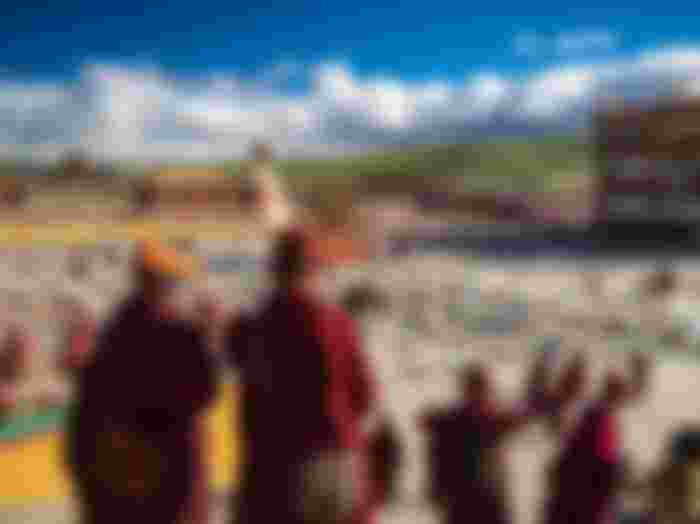About 10,000 Nyingma monks live on a remote plain in the Garzi area, along the Jin-Chu River. Some of them are meditating in their huts, some are running to be initiated by Guru Lama, some are praying in unison. The name of this ashram is 'Yarken Garh' which is spread over an entire village in Garji area. The days of the monks here are spent in an unpretentious way of life, with the aim of enriching life with faith and religious reform.

Yarken Average, also known as ‘Yaken Wargan Monastery’. The foundation stone of the Yarken Average was laid by Lama Rinpoche in 1985. The Buddhist monastery is located in the Baiyu division of the autonomous province of Garzi in Tibet. Although not easily accessible, the monastery is one of the largest Buddhist monasteries in the world, located at an altitude of 4,000 meters above sea level. The Nyengma tradition of Tibetan Buddhism is associated with the Yarken Gar management system. At present, the ashram, which covers an entire village, has 10,000 Sangha members, most of whom are women.
Founded in 1985, the monastery is located 400 kilometers west of Chingdu, the old Tibetan province inhabited by the Kham rulers. Despite being larger in size than the nearby ‘Ladung Garh’, it is better known as the Dharmashibir of the average monks from the ashram. When the Beijing and Chengdu authorities launched an eviction campaign in 2001, thousands of Buddhist monks fled the Ladung average and settled in Yarken. Their houses were also destroyed in Ladung. Although the Ladung average has been off-limits to outside tourists since June 2016, the Yarken average is open to all. Ladung is surrounded by the average hill, and the river flows around the Yarken average.

Achchuk Rinpoche (1927-2011), was the longest serving abbot of the Yerchen Garh. He was one of the veteran teachers of Naingma initiation in Tibet and he was a believer in ‘Yagshen’. ‘Yagshen’ is a practice of Tibetan Buddhist teaching that explores the primitive origins behind the creation of beings. Rinpoche taught both Tibetan and Chinese, and many students from all over China flocked to him. Besides, people from all over the world used to come to him for healing.
On the way to the ashram, the entire village can be seen from the top of the hill where the statue of Guru Rimpuch is located. The small huts of the Buddhist nuns in the middle of the village, the houses of the male monks in the west - everything is visible from here.

At the foot of the hill there is a meditation room for nuns. These meditations are made of wood, iron sheets; A few again made of cloth and transparent glass. Some monks meditate for about 100 hours a day, 24 hours a day, in their own meditation halls. They just leave their meditation to respond to the call of nature or eat food. In addition to meditating, Buddhist monks run small shops. These stores include cloaks, hats (yellow hats are made for Gelug school students and red hats are made for shakyas), shoes, electrical appliances (some monks also use headphones and smartphones nowadays) and other items.

Monks cannot enter nuns' homes - this rule is strictly followed in the Yarken average and applies to visitors as well. The Buddhist monks at the monastery had a difficult time keeping the teachings of the founder Lama Rinpoche in their lives. These life-oriented teachings of Lama Rinpoche speak of living through meditation, hard work, and atonement for one's deeds. Near the ashram is a hill, with a circular path at its center; It is along this path that the monks of the ashram mainly observe ‘Kuto’. ‘Kutoo’ is a type of prayer, where after every two steps while walking along this circular path, they squat down and rest their foreheads on the ground, praying for peace and wisdom.

Whatever the weather, every day from 8 am to 11 am, thousands of monks and nuns come to the courtyard to listen to the Chief Lama and pray.

There are many monasteries (most of which are located in the vicinity of the nuns' huts) scattered throughout the area of Yarken Garh, where religious subjects are taught in the classroom during the day. From the roofs of the monasteries one can see the beautiful scenery of the village and the surrounding natural beauty. The monasteries are generally open to tourists.

The living conditions are much better now than they were in the last few years, but there is no limit to the suffering of the monks and nuns here in the winter! Every winter, a monk begins to stay in a hut for 100 days. All these huts are about one square meter in size and have to withstand temperatures of almost zero degrees.
The majority of the Yarken average population was formerly inhabited by the surrounding Ladung average. They fled during the search and eviction by the government. It takes about three hours to reach Yarken on average by minivan from the city of Gargi. There is only one hotel here for outside tourists to stay, the name is Ya King Hotel. It costs about 120 yen to stay one night. But the luxury of staying here is not to be expected at all. Everything here is old-fashioned and very simple, like the lifestyle of a huge ashram set up across the village. There is a restaurant on the ground floor of the hotel, but no menu can be found here. Eating meat is forbidden here. There are small shops on either side of the hotel entrance where soup, bread and other items can be found.

Much of the beauty of the ashram that is observed from the top of the hill fades away when approached. As you get closer, you can easily see the dilapidated condition of housing throughout the village. It can be seen that most of the houses are made of mud, plywood and old metal - which is the reason for the suffering of the people living in winter. There is no water facility, work has to be done with rain water. The smell of urine comes from different places as there is no effective system of drainage.

Although the Yarken average is currently blessed by the touch of many technologies, it is still quite difficult for monks to make a living here. Most of the toilets are located on the banks of the river. The same water in which the excrement is mixed is being used for washing food and utensils. For all these reasons, typhoid occasionally occurs in large numbers in this area. But steps are being taken by the government to remove all these problems.

Since most of the monks living in the Yarken average are women, the Yarken average is called ‘the city of nuns’ or ‘The city of nuns.’ In the last few years, the population has grown so rapidly that the authorities have issued separate living rules for male and female monks. It also separates the living areas of men and women.
Most of the monks in the monastery are Tibetans, and very few of them can speak Mandarin. Although the inhabitants of Garzi claim to be descendants of primitive Tibetans, there is some ambiguity as to how true this statement is.

The Chinese government passed a new law in 2018 for the Yarkin average, which puts the residents at great risk. Under the new law, no new house or old house can be built in the Second Division area. If the reconstruction is very urgent, then you have to apply to the authorities with pictures and letter of recommendation. Also, according to another law made in 2017, about 3,500 houses were demolished. As the reason is shown, all these houses have been demolished to make way for roads. A similar catastrophe took place in 2002, destroying about 2,000 homes and displacing about 4,000 people.

Living far away from the hustle and bustle of people's daily lives is quite difficult to live on average. In addition to hearing the message of peace in the air here, the story of surviving against adverse weather also floats.

Due to the constant evictions of the government, the monks here have to live in fear, as well as have to spend the day in a temperature of almost zero degrees, eliminating all luxuries. But despite all this, the people here are arranging their daily lives with a purpose. With the life of Guru Lama, they are constantly moving towards purity.
Thanks for reading this article for so long.
If you like it Upvote Can give.













Interesting article. Thanks